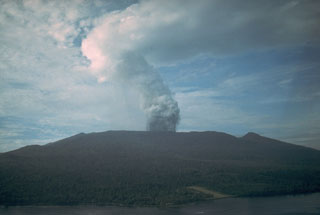Report on Karkar (Papua New Guinea) — April 1979
Scientific Event Alert Network Bulletin, vol. 4, no. 4 (April 1979)
Managing Editor: David Squires.
Karkar (Papua New Guinea) New crater lake; ash eruptions continue
Please cite this report as:
Global Volcanism Program, 1979. Report on Karkar (Papua New Guinea) (Squires, D., ed.). Scientific Event Alert Network Bulletin, 4:4. Smithsonian Institution. https://doi.org/10.5479/si.GVP.SEAN197904-251030
Karkar
Papua New Guinea
4.647°S, 145.976°E; summit elev. 1839 m
All times are local (unless otherwise noted)
"Activity fluctuated during April, but was generally weaker than in March. Strong grey ash emission occurred more or less continuously 7-18 April. Tightly convoluted ash clouds rose to several hundred meters above the vent. The ash plume reached as much as 30 km downwind (mainly eastward) on some days. Ashfalls early in the month were heavy enough at times to prevent work on plantations and village gardens on the E side of the island. The ash changed in dominant color from grey and brownish-grey to black around 18 April. [Patches of incandescent rocks] were observed inside the crater on 10 April and intermittently since that time.
"A churning, steaming, brown-colored lake was first observed 23 April in the bottom of the new explosion crater, which opened on 12 or 13 January to about 75 m in diameter and greatly enlarged, to about 300-400 m in diameter, in the fatal explosions of 8 March. Eruptions occurred through this lake, producing black ash ejections reminiscent of shallow marine volcanic explosions. Most had insufficient energy to leave the estimated 150-200 m-deep crater except on rare occasions, when a few blocks fell near but outside the crater. Lake level appeared to fluctuate greatly. Although clearly visible on 23 April, the lake was not visible the next day, following a period of heavy black ash emission, probably during the night, that deposited about a centimeter of ash on the SW side of the crater. Sounds at the crater edge during subaqueous explosions were like those of some geysers, and were accompanied by a tinkling noise probably produced by fallback. Aerial inspection on 28 April revealed very large black ash emissions to 200 m above the crater rim, with some blocks falling outside the crater. Frequency of explosions was nearly continuous, every second or less.
"Seismic activity consisted of irregular distinct periods of strong tremor l-14 April. From 15 April, seismic activity consisted of steady low-amplitude tremor, with a few distinct B-type shocks on most days. Gravity stations were established on 13 April [in an effort to detect any possible subsurface mass changes or elevation changes]. Twelve remeasurements were made during the month. Three stations are on the caldera floor, two on the rim, three on the mid-flanks, and four along the coast. The measurements indicated that no major [subsurface mass changes], rapid uplift, or subsidence of the caldera floor was occurring. The sensitivity of these measurements is estimated at ±10 cm [for elevation changes]. Between 18 and 22 April, four dry tilt stations were installed, one on the caldera rim, one on the coast, and two at intermediate points. As of the end of April, relevelling of these had not revealed significant changes in tilt."
Geological Summary. Karkar is a 19 x 25 km forest-covered island that is truncated by two nested summit calderas. The 5.5 km outer caldera was formed during one or more eruptions, the last of which occurred 9,000 years ago. The steep-walled 300-m-deep, 3.2 km diameter, inner caldera was formed sometime between 1,500 and 800 years ago. Cones are present on the N and S flanks of this basaltic-to-andesitic volcano; a linear array of small cones extends from the northern rim of the outer caldera nearly to the coast. Recorded eruptions date back to 1643 from Bagiai, a pyroclastic cone constructed within the inner caldera, the floor of which is covered by young, mostly unvegetated andesitic lava flows.
Information Contacts: C. McKee, RVO; W. Melson, SI, Washington DC.

